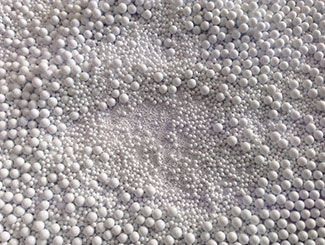 by Alberto Barbieri28
Aprile
2014
by Alberto Barbieri28
Aprile
2014
More efficiency with alumina
The use of alumina instead of zirconia cuts down costs and opens up important opportunities in the inkjet sector
An important innovation in raw materials for ceramics has been presented at Cevisama this year. Xieta International Ltd., a prominent firm in the production of alumina balls and coatings for ceramics has presented its last technological innovation: alumina microspheres for high-energy mills. The trade name of this important innovation will be ‘Alumina Beads Xieta AZ’, and will provide the market with alumina microspheres for grinding processes, replacing zirconia balls with the same effects.
The product has been tested in different ways by Xieta itself and by Maincer under the supervision of the ITC – the Institute of Ceramics Technology of Castellón, in particular of the department of nanomaterials and nanotechnologies. Several tests were implemented to measure the grinding efficiency. By using a praseodymium yellow pigment (density about 4.65 g/cm3) alumina microspheres and zirconia balls have been compared as to their grinding efficiency in a high-energy mill. Results have been satisfactory: the AZ microspheres have proven slightly more efficient than zirconia ones: 0.25 micron (alumina) against 0.29 micron (zirconia). But the most significant fact is that alumina, with a density of about 3.7 g/cm3 (and a packing density of 2.1 kg/l), can perfectly replace zirconia, which has a density of 6.10 g/cm3 (and a packing density of 3.7 kg/l). Which means that 100 litres would require 370 kg zirconia while only 210 kg alumina. Considering that alumina is considerably less expensive than zirconia it becomes evident that alumina has great potentialities in this field.
It has therefore been demonstrated that the different specific weights of the materials do not affect grinding efficiency. That leads to the possibility of high-energy grinding using materials with lower specific weight as long as they can stand high-energy conditions and have a very high resistance to wear. In the laboratory tests made by Xieta and ITC, and based on a 14 hour working shifts, no fragments or breach have been found, which means that the product should last at least as much as zirconia balls. Furthermore, although with no certain data yet, it is likely that energy consumption will be reduced as well since alumina microspheres will have a smaller volume to rotate.
Xieta has already implemented its own pilot production line, says Jordi Martínez, manager technology of Research&Development area, and has started business with several Spanish ceramic factories interested in the product whose application on an industrial scale is supposed to start in order to present definitive results at the next Tecnargilla fair. Although the last and definitive test on the validity of alumina microspheres will by no doubt be their full use on an industrial scale, it is likely that this approach be used also in the inkjet grinding sector, which up to now has been ruled by zirconia balls. Alumina, thanks to its lighter weight and more accessible price, will allow to cut down grinding costs.
General properties
Main raw material Calcined alumina
Alumina content (%) ≥ 93.5
Density (g/cm3) 3. 75 ± 0.05
Colour White
Mohs Strenght 9
Vickers Strength (0.5 kg) 1200 ± 50
Compressive strenght (kgf-2mm) ≥ 200
Thermal expansion coef. 7-8
Chemical composition
AI203 (%) ≥ 93.5
Si02 (%) ≥ 3.00
Altri (%) ≥ 3.50
Available sizes
Diameter (mm) Diameter (mm)
0.25 - 0.34 2.5 - 3.0
0.34 - 0.44 3.0 - 3.5
0.4 - 0.6 3.5 - 4.0
0.8 - 1.2 4.0 - 4.5
1.6 - 1.8 4.5 - 5.0
2.0 - 2.5 5.0 - 10